Magnetism | Term 3 Unit 1 | 6th Science - Student Activities | 6th Science : Term 3 Unit 1 : Magnetism
Chapter: 6th Science : Term 3 Unit 1 : Magnetism
Student Activities
You might have seen magnets. Have you ever enjoyed playing with them?
Take a steel glass. Take a needle through which thread is passed. Press the thread with a finger near the hole of the needle as shown in the figure and raise the glass upward slowly.
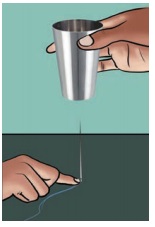
What happens?
---------------------------------------------------------------
Observe the same activity performed by your teacher and note it.
------------------------------------------------------------------------
Activity 1: Take a magnet. Take the magnet Closer to the objects surrounding you.
What happens? Observe and note.
The objects attracted by the magnet:
The objects, not attracted by the magnet:
Which substances are used to make the objects attracted by the magnet?
Place some iron filings on a paper. Place a bar magnet horizontally in the filings and turn it over a few times. Now lift the magnet. What do you see? Which part of the magnet has more iron filings sticking to it? _____________
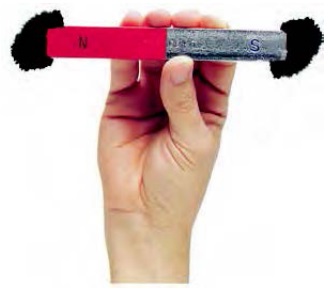
Which part of the magnet has almost no filings sticking to it? _______________
The parts of the magnet those attract the largest amount of iron filings are called as its poles. The attractive force of the magnet is very large near the two ends. These two ends are called its poles.
If you have a horseshoe magnet, or any other type of magnet at home, find the position of its poles by this experiment.
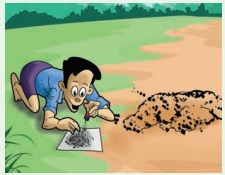
In experiments with magnets you will need to use iron filings again and again. You can do this by placing a magnet in a pile of sand and turning it around in the sand. The small pieces of iron present in the sand will stick to the magnet. If you cannot find sand you can look for iron pieces in clayey soil as well.
If you don’t have iron filings, you can collect small pieces of iron and they will serve the purpose as well.
Turn the magnet gently and let it come to stop again. Repeat it three or four times.
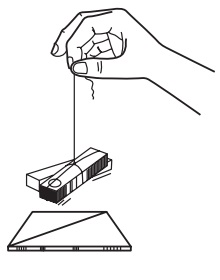
Does the bar magnet stop in the same direction each time?
--------------------------------------------------
In which direction does the magnet stop every time ? ---------------------------------------
This is roughly the north-south direction. The end of the magnet that points to the north is called the North Pole. The end that points to the south is called the South Pole.
A freely suspended magnet always comes to rest in north-south direction.
The directive property of magnets has been used for centuries to find directions. Around 800 years ago, the Chinese discovered that a suspended lode stone stops in the north-south direction. Chinese used these lode stones to find directions.
The navigators of that country used to keep a piece of lode stone suspended in their boats and during a storm or mist, they used the lode stone to locate directions.
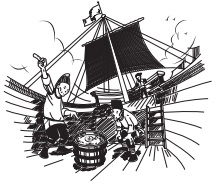
Take two similar magnets, place them in four different ways as shown in Figure.
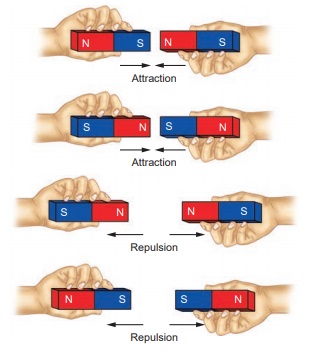
What do you observe? When do the magnets attract each other?
-----------------------------------------------------------
-----------------------------------------------------------
When do the magnets repel each other?
-----------------------------------------------------------
-----------------------------------------------------------
Unlike poles (S-N, N-S) attract each other. Like Poles (N-N, S-S) repel each other.
Activity 2: LET US MAKE MAGNETS
Take a nail / a piece of Iron and place it on a table. Now take a bar magnet and place one of its poles near one edge of the nail / piece of Iron and rub from one end to another end without changing the direction of the pole of the magnet. Repeat the process for 30 to 40 times.
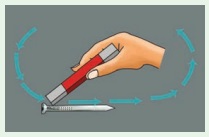
Bring a pin or some iron filings near the nail / piece of Iron to check whether it has become a magnet. Does the nail/ piece of iron attract the pin / iron filings? If not, continue the same process for some more time.
Do magnets lose their properties ? When?
Magnets lose their properties if they are heated or dropped from a height or hit with a hammer.
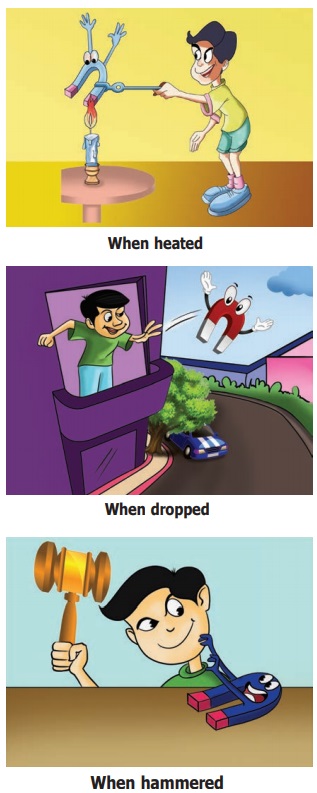
Magnets lose their properties when they are placed near Cellphone, Computer, DVDs. These objects will also get affected by magnetic field.
Activity 3: Make your own magnetic compass
Insert the magnetized needle, that you made in the activity 2, in to two styrofoam balls (Thermocol balls) and place the needle in bowl of water. Test whether the floating needle is always turned in rest on north - south direction.
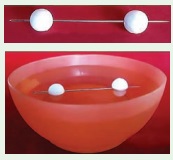
Note: If you don't have styrofoam balls you can use dry leaf or a cork piece.
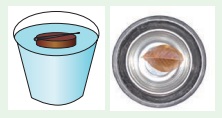
We Know that Like poles of the magnet repel each other. Keep two Bar magnets as shown in the Figure.
What do you observe? ---------------------------------------------------
By using repulsion we can levitate a magnetic object. Let us make a toy and enjoy magnetic levitation.
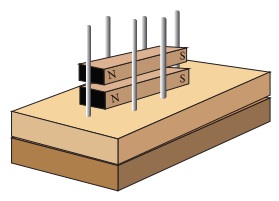
Have you enjoyed with this toy? Electromagnetic train is working in the same principle. Have you heard about it?
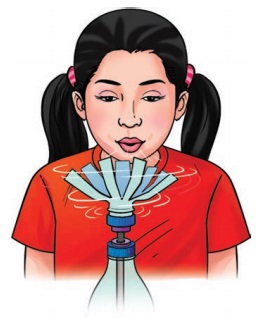
Write the differences between a normal train and an electromagnetic train.
Normal train
1. Runs on iron rails.
2. Uses fuels like coal, diesel and electricity.
3. Makes a lot of noise due to the presence of moving parts.
4. Runs at moderate speed.
5. Leaves out fumes that spoil the eco-system.
Electromagnetic train
1. Runs above the rails without touching them.
2. Uses the attractive and repulsive forces of magnets.
3. Runs without noise as it has no moving parts.
4. Travels at high speed.
5. Eco-friendly in nature.
Related Topics